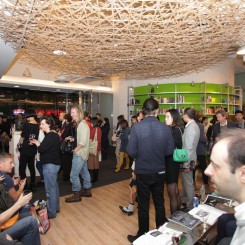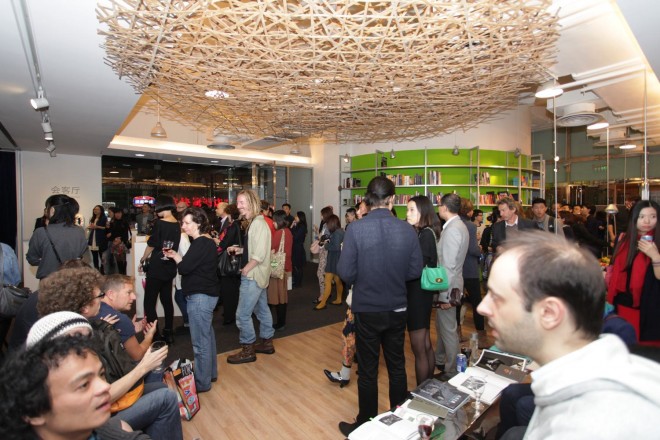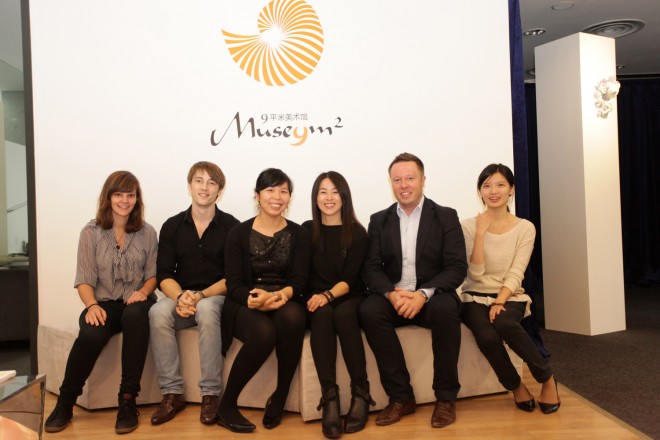Goethe Open space 2 Project: “9 Square-Meter Museum”
Department of Culture and Education at the German Consulate-General Shanghai (Room 101, Fuzhou Road 318, Shanghai) Oct 18–Oct 21, 2013
What implications lie behind nine square-meters? In the luxurious residences within Shanghai’s city center, it might be smaller than a well-appointed master bathroom. It might even be smaller than a single piece of art displayed in today’s grand and numerous art museums. “Size matters”—this oblique saying sets the imagination running toward a number of corners regardless of what context it is employed in. Admiration for the grand, and neglect for the tiny is a matter of course, but the questions we should be asking next are “What is the purpose of size?” and “What ideas does it spark in us?” In an era when art museums are expanding into veritable palaces of art, when galleries balloon into private museums, and when art scenes which were once integral in the city center become pushed towards the margins, towards empty lots and warehouses on the fringes of cities, what has art become?
Not long ago, the Department of Culture and Education at the German Consulate-General Shanghai opened its doors to the public, and its humble drawing room became the site for this quarter’s Goethe-Institut Open Space. The project was called “Nine Square-Meter Museum”, and the Consulate’s drawing room became the exhibition space. The exhibition lasted just one day in order to impart a sense of urgency, and also begged the question, “What possibilities can art bring in nine square-meters and twenty-four hours?”
Video works were directly played back on a laptop placed atop a table, and different installations were placed on tiny platforms of various sizes. “Snail homes” (woju; ) are practically the common theme in the exhibition. Liu Ren’s work “Universe” consisted of English words tucked inside egg shells; the deeper meanings of the words formed a dramatic counterpoint to the fragility of the eggshells. Liu has always maintained his approach of utilizing fragile materials to express grand, overarching themes, and here, he has again cleverly utilized this contrast to express his attitude towards life. What could his piece be if not a wry commentary on his own life as a young man living under the pressures inherent in the megalopolis that is Shanghai?
One gets the sense of another type of “snail home” in Gao Mingyan’s miniature installations. Gao has installed his own miniature library within an exquisite, hard-cover real-estate brochure. The artist couldn’t help but carve his and the names of his past loves on the walls of this library, where a miniature version of himself sits, reading. As a record of life, art always ends up putting the artist’s own life on show. This can be seen in Huzi’s piece, “Self Portrait”. The artist has tucked her likeness, peeping out from behind some curtains, in between two full and luscious lips and also a svelte pair of legs. The feeling of uncertainty in our attitudes towards life, our ever-changing moods, and the ever-present sense of loneliness are just some of the complicated emotions all of us deal with in our day and age.
For his piece entitled “Emancipaton electric”, Shang Chengxiang created a model of the brain with a technique that borders mimetic representation, and then attached the model to an automatic vacuum cleaner, allowing it to roam the floor of the exhibition space. However, the motion of the vacuum cleaner as it jerked about bearing its heavy load came off as a touch neurotic. Rather, it was Jin Shan’s piece “Little Bastard” that achieved a humorous and surprising effect, and was able to shift the viewers’ moods; the artist attached cherubs onto the pillars of the drawing room, with their countenances slightly altered, so the surprise felt by the viewers and the cherubs themselves was perhaps mutual. Clearly, most of the artists’ works expressed individual sentiments, contradictions, and the wayward wandering of their minds—a combination of their mocking and playful attitudes that are a true reflection on life.
The parlor or living room is the heart of any city-dwelling family’s residence; similarly, the evening of the opening ceremony also felt like a gathering hosted at a friend’s home. The room was filled with faces both familiar and unfamiliar, while attendees viewed art and chatted with each other — life and art on intimate terms. As a rehearsal and prelude to future art projects hosted at the Goethe-Institut’s Open Space, this exhibition has raised a series of important questions. It inspired a different way of approaching the concept of museums, and challenged the way we view them. As contemporary art in China emerges from its struggle for legitimacy, what will be the next goal to strive for? The curator of the Goethe-Institut Open Space project, Zhang Bing, has laid out some definitions she has long been seeking; for example, the exhibit examines the links between artistic creation and exhibition, exhibition and space, space and art systems. All of the artists participating in the “Nine Square-Meter Museum” show are very young, and every work on show was small in size, completed at very little cost. It can be seen that an exhibition involving nearly ten artists can be done on a tight budget, and can furthermore be well executed.
During the 90s, the curator Hans Ulrich-Obrist hosted an exhibition out of the kitchen in his own home. He later collaborated with Hou Hanru to coordinate the Cities on the Move exhibitions, undertaking artistic experiments based on local conditions in a series of different cities, allowing art programs and exhibitions to grow and evolve naturally. In recent years, miniature art spaces have been popping up all over the mainland. Arrow Factory — situated in one of Beijing’s hutongs — and Bazaar Compatible — located within the small markets of Shanghai’s Anshun road — are just two examples which show the practicability of small, independent arts organizations. Today, we are gratified to see that this mode of contemporary art exhibition is still alive and well in the parlor of the Department of Culture and Education at the German Consulate-General in Shanghai.




